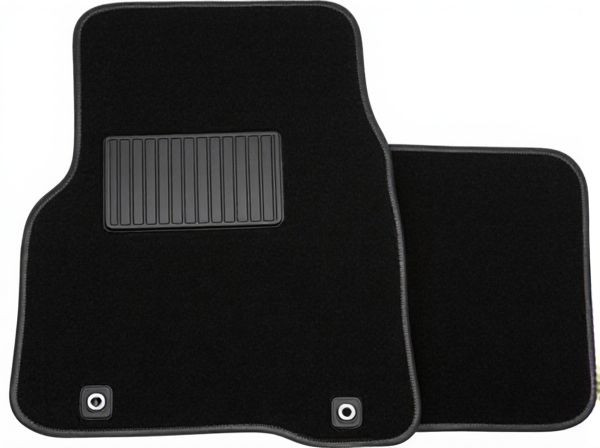
Photo illustration: Snap-In Floor Mat vs Non-Snap-In Mat
Snap-in floor mats offer a secure fit by snapping into place, preventing movement and providing better protection for your vehicle's interior. Non-snap-in mats are easier to install and remove but may shift during use, potentially exposing the floor to dirt and wear. Choosing snap-in mats ensures stability and enhanced safety by reducing the risk of mat slippage under pedals.
Table of Comparison
| Feature | Snap-In Floor Mat | Non-Snap-In Floor Mat |
|---|---|---|
| Attachment | Secured with snaps or clips to prevent movement | Lays freely without attachment points |
| Stability | High stability, reduces slipping and shifting | Lower stability, prone to sliding around |
| Safety | Improves driver safety by staying in place | Potential hazard due to mat bunching or sliding |
| Installation | Requires alignment with vehicle snaps for installation | Easy placement, no special fitting needed |
| Cleaning | Can be removed for thorough cleaning but needs reattachment | Simple removal and cleaning without reattachment |
| Compatibility | Designed for specific vehicle models with snap anchors | Universal fit, suitable for various vehicles |
| Durability | Typically more durable due to secure placement | Durability varies, may wear faster due to movement |
Introduction to Floor Mats: Snap-In vs Non-Snap-In
Snap-in floor mats feature built-in retention systems that securely anchor them to the vehicle's floor, preventing shifting and enhancing safety. Non-snap-in mats lack these attachment points, offering more flexibility but a higher risk of movement during driving. Choosing between snap-in and non-snap-in mats depends on the vehicle model compatibility and user preference for security versus ease of removal.
What Are Snap-In Floor Mats?
Snap-in floor mats are custom-fit automotive mats designed with securing mechanisms, such as clips or hooks, that anchor them firmly to the vehicle's floor, preventing movement and enhancing safety by reducing slippage. These mats are precisely molded to match the contours of specific car models, providing superior coverage and protection against dirt, spills, and wear. Unlike non-snap-in mats, snap-in floor mats offer a stable, secure fit that helps maintain cleanliness and prevents interference with pedal operation, making them an ideal choice for vehicle owners seeking both functionality and safety.
Features of Non-Snap-In Floor Mats
Non-snap-in floor mats are designed for universal fitment, offering flexibility across various vehicle models without the need for specific attachment points. These mats typically feature a lightweight construction and easy removal for cleaning, enhancing convenience for everyday use. While they may lack secure anchoring systems, their versatility and affordability make them a popular choice for drivers prioritizing simplicity over fixed positioning.
Installation Process Comparison
Snap-in floor mats feature integrated snap fasteners that securely attach to compatible anchors on the vehicle floor, ensuring a precise fit and preventing mat movement. Non-snap-in mats rely on gravity and shape to stay in place but may shift during driving, potentially causing safety concerns. Installation of snap-in mats is quick and straightforward, aligning with factory retention points, while non-snap-in mats require manual adjustment to fit properly without fixed anchoring.
Safety and Stability Differences
Snap-in floor mats provide enhanced safety and stability by securely fastening to the vehicle's floor, preventing mat movement that can interfere with pedal operation. Non-snap-in mats lack this secure attachment, increasing the risk of slipping or sliding, which may cause dangerous interference while driving. The snap-in design minimizes the chance of mats bunching or sliding underfoot, significantly reducing hazards and improving driver control.
Material Quality and Durability
Snap-in floor mats are typically made from high-quality, heavy-duty rubber or thermoplastic materials designed for enhanced durability and a secure fit, preventing shifting during use. Non-snap-in mats often consist of lighter, less dense rubber or carpet materials that may wear out faster and provide less resistance to moisture and dirt. The superior material quality of snap-in mats ensures longer lifespan and better protection for vehicle interiors.
Ease of Cleaning and Maintenance
Snap-in floor mats securely anchor into place, preventing movement and trapping dirt, which simplifies vacuuming and spot cleaning by keeping debris confined to specific areas. Non-snap-in mats, however, tend to shift during cleaning, requiring extra effort to lift and reposition them for thorough maintenance. The fixed position of snap-in mats reduces wear from constant shifting, enhancing durability and ease of upkeep over time.
Cost Analysis: Snap-In vs Non-Snap-In Mats
Snap-in floor mats typically cost more upfront, ranging from $50 to $150 depending on the vehicle model, due to their custom fit and secure attachment features. Non-snap-in mats are generally cheaper, priced between $20 and $70, but may shift during use, potentially causing wear or safety issues. Considering longevity and safety, snap-in mats offer better value despite the higher initial investment, reducing replacement frequency and enhancing vehicle protection.
Best Use Cases for Each Type
Snap-in floor mats provide secure, custom-fit coverage designed to stay firmly in place, making them ideal for vehicles that experience heavy use or require precise protection against dirt, water, and wear. Non-snap-in mats offer versatile, universal fit options suitable for occasional use or vehicles where easy removal and cleaning are priorities. Selecting snap-in mats is best for daily drivers, work trucks, and family vehicles, while non-snap-in mats suit rental cars, occasional-use vehicles, and situations needing quick mat replacement.
Which Floor Mat Should You Choose?
Snap-in floor mats offer a secure fit with clips or fasteners that prevent shifting, making them ideal for vehicles with heavy use or harsh weather conditions; they often provide better protection by fully covering the vehicle's floors. Non-snap-in mats are easier to install and remove, providing more versatility for quick cleaning and casual use, but they may move around, reducing protection during driving. Choose snap-in mats for maximum stability and coverage, especially in rugged conditions, while non-snap-in mats suit drivers seeking convenience and flexibility.
 caratoz.com
caratoz.com